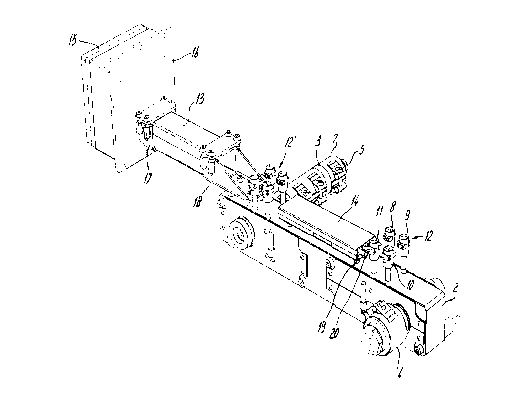Some of the information on this Web page has been provided by external sources. The Government of Canada is not responsible for the accuracy, reliability or currency of the information supplied by external sources. Users wishing to rely upon this information should consult directly with the source of the information. Content provided by external sources is not subject to official languages, privacy and accessibility requirements.
Any discrepancies in the text and image of the Claims and Abstract are due to differing posting times. Text of the Claims and Abstract are posted:
| (12) Patent Application: | (11) CA 2260515 |
|---|---|
| (54) English Title: | MODULAR CABLE GUIDE SYSTEM |
| (54) French Title: | CONDUIT ELECTRIQUE MODULAIRE |
| Status: | Deemed Abandoned and Beyond the Period of Reinstatement - Pending Response to Notice of Disregarded Communication |
| (51) International Patent Classification (IPC): |
|
|---|---|
| (72) Inventors : |
|
| (73) Owners : |
|
| (71) Applicants : |
|
| (74) Agent: | MCCARTHY TETRAULT LLP |
| (74) Associate agent: | |
| (45) Issued: | |
| (22) Filed Date: | 1999-01-28 |
| (41) Open to Public Inspection: | 1999-07-28 |
| Examination requested: | 2003-12-29 |
| Availability of licence: | N/A |
| Dedicated to the Public: | N/A |
| (25) Language of filing: | English |
| Patent Cooperation Treaty (PCT): | No |
|---|
| (30) Application Priority Data: | ||||||
|---|---|---|---|---|---|---|
|
The invention relates to a modular cable guide system for use in an
injection moulding apparatus comprising
- at least one first cable guide conduit,
- at least one connector having a sleeve for fitting around a first
end of the first cable guide conduit, clamping means for tightening the
sleeve around the first cable guide conduit for forming a clamping
connection with the conduit and a coupling member for connecting the
connector to a machine part or to another cable guide conduit, and
- a second cable guide conduit having a number of regularly spaced
connecting holes for receiving coupling elements for connecting the
second guide conduit to the machine part.
The system according to the invention can be easily installed and
can be made to the right size and placed into the right configurations
upon installation.
Note: Claims are shown in the official language in which they were submitted.
Note: Descriptions are shown in the official language in which they were submitted.

2024-08-01:As part of the Next Generation Patents (NGP) transition, the Canadian Patents Database (CPD) now contains a more detailed Event History, which replicates the Event Log of our new back-office solution.
Please note that "Inactive:" events refers to events no longer in use in our new back-office solution.
For a clearer understanding of the status of the application/patent presented on this page, the site Disclaimer , as well as the definitions for Patent , Event History , Maintenance Fee and Payment History should be consulted.
| Description | Date |
|---|---|
| Application Not Reinstated by Deadline | 2008-01-28 |
| Time Limit for Reversal Expired | 2008-01-28 |
| Deemed Abandoned - Failure to Respond to Maintenance Fee Notice | 2007-01-29 |
| Letter Sent | 2004-01-20 |
| Request for Examination Received | 2003-12-29 |
| Request for Examination Requirements Determined Compliant | 2003-12-29 |
| All Requirements for Examination Determined Compliant | 2003-12-29 |
| Inactive: Cover page published | 1999-08-02 |
| Application Published (Open to Public Inspection) | 1999-07-28 |
| Classification Modified | 1999-03-24 |
| Inactive: First IPC assigned | 1999-03-24 |
| Inactive: IPC assigned | 1999-03-24 |
| Inactive: IPC assigned | 1999-03-24 |
| Inactive: IPC assigned | 1999-03-23 |
| Inactive: Filing certificate - No RFE (English) | 1999-03-03 |
| Filing Requirements Determined Compliant | 1999-03-03 |
| Application Received - Regular National | 1999-03-03 |
| Abandonment Date | Reason | Reinstatement Date |
|---|---|---|
| 2007-01-29 |
The last payment was received on 2006-01-19
Note : If the full payment has not been received on or before the date indicated, a further fee may be required which may be one of the following
Please refer to the CIPO Patent Fees web page to see all current fee amounts.
| Fee Type | Anniversary Year | Due Date | Paid Date |
|---|---|---|---|
| Application fee - standard | 1999-01-28 | ||
| Registration of a document | 1999-01-28 | ||
| MF (application, 2nd anniv.) - standard | 02 | 2001-01-29 | 2000-12-19 |
| MF (application, 3rd anniv.) - standard | 03 | 2002-01-28 | 2001-11-27 |
| MF (application, 4th anniv.) - standard | 04 | 2003-01-28 | 2003-01-07 |
| Request for examination - standard | 2003-12-29 | ||
| MF (application, 5th anniv.) - standard | 05 | 2004-01-28 | 2004-01-23 |
| MF (application, 6th anniv.) - standard | 06 | 2005-01-28 | 2005-01-25 |
| MF (application, 7th anniv.) - standard | 07 | 2006-01-30 | 2006-01-19 |
Note: Records showing the ownership history in alphabetical order.
| Current Owners on Record |
|---|
| DYNISCO HOTRUNNERS B.V. |
| Past Owners on Record |
|---|
| FRANCISCUS ANTONIUS JOSEF VAN BOEKEL |